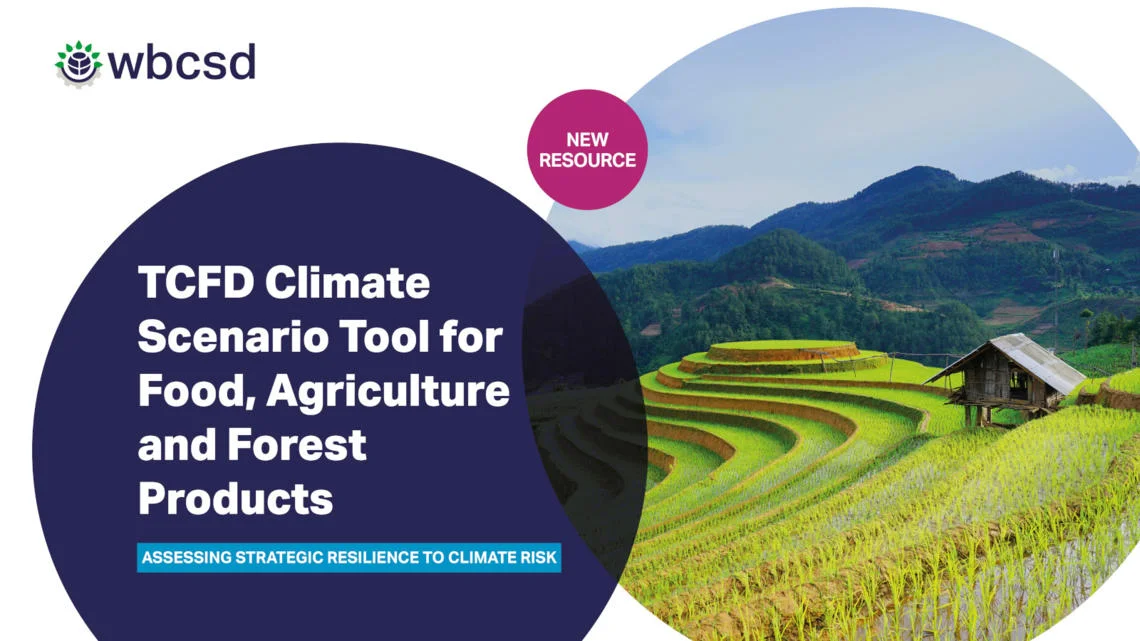The tool will explore plausible futures and help companies understand climate risks and opportunities.
Geneva, 29 November 2022: Today, the World Business Council for Sustainable Development (WBCSD) launches a new Climate Scenario Tool, which includes the first-ever climate scenarios designed specifically for the Food, Agriculture and Forest Products sectors. This tool complements WBCSD’s existing Energy climate scenario tool.
Climate scenario analysis allows a company to understand how it might perform under different hypothetical climate futures. The Task Force on Climate-related Financial Disclosures (TCFD) recommends climate scenario analysis for companies reporting on and preparing for transition risks and opportunities.
There is a growing need for scenario analysis. For instance, the U.S. Securities and Exchange Commission’s (SEC) proposed climate disclosure rule will require disclosure of details on a company’s use of scenario analysis to assess the impact of climate-related risks on its operations and business model. Additionally, the International Sustainability Standards Board (ISSB) recently voted to confirm that companies must use climate-related scenario analysis to report on climate resilience and identify climate-related risks and opportunities to support their disclosures. Companies need new tools and better support to evaluate climate risks and opportunities, build transition plans, and report in line with recommendations from the TCFD.
While the Food, Agriculture and Forest Products sectors are steadily using more quantitative scenario analysis as an essential method to assess strategic resilience, approaches remain inconsistent and not comparable due to varying scenario applications.
WBCSD convened leading Food, Agriculture and Forest Products companies to develop a set of new sector-relevant climate transition scenarios to assess strategic resilience to climate risk and inform disclosures in response to the recommendations of the TCFD. These scenarios are available effective today through an online tool that enables users to navigate by specific variables (e.g., commodities and regions) and compare, visualize, and download output data (e.g., production, prices, and emissions).
“Scenario analysis is an increasingly important tool as companies seek to understand how to navigate climate transition risks. Having a consistent set of scenarios for the forest sector that considers the dynamics with other land use provides a solid foundation and starting point for engaging the entire organization around climate transition risks,” said Sophie Beckham, VP and Chief Sustainability Officer at International Paper. “We’re excited about the prospects for how these scenarios can help to inform Enterprise Risk Management for our organization and others in our sector.”
The Climate Scenario Tool offers outputs covering business, land use, and environmental factors across 23 crop, animal product, and forest product commodities and 18 regions.
“It’s encouraging to see the private sector take a science-based approach to assess different climate scenarios for food, agriculture, and forests,” said Dr. Franziska Gaupp, Senior Researcher at the Potsdam Institute for Climate Impact Research. “The scenarios developed by WBCSD can enable companies to build a shared understanding of future climate-related risks and opportunities and help drive alignment of decision-making and business strategy within planetary boundaries.”
Companies can use the scenarios to explore possible futures and drive discussions with risk management, procurement, strategy and other parts of the business around:
- Public and policy engagement: a tool for policy discussions based on scientific data.
- Strategic adaptation and resilience: inform assessments of business model resilience and understand how transition risks and opportunities could materialize.
- Financial impact: a starting point for describing how transition risks and opportunities can link to the financial effects.
- Reporting and disclosure: a basis for TCFD-aligned reporting, investor conversations and alignment with specific temperature targets.
“Leading companies are rethinking their business models to respond to the challenges and opportunities posed by climate change,” said Ryan Whisnant, Manager, TCFD Reference Scenarios, WBCSD. “WBCSD is pleased to launch this new, free, online tool to help many companies develop transition plans to align with a low-carbon future.”
This project is made possible through funding from the Gordon and Betty Moore Foundation and the Norwegian International Climate and Forest Initiative’s Funding Scheme. As the technical knowledge partner for this effort, Vivid Economics by McKinsey provided economic and land use modeling and scenario development support. PwC provided business application, training, and transition planning support.
Access the new TCFD Reference Scenario Tool for Food, Agriculture and Forest Products here. To view a list of the TCFD Reference Scenario Tool member companies, visit our website.
WBCSD news articles and insights may be republished in accordance with the Creative Commons Attribution-NonCommercial-NoDerivatives 4.0 International Public License, and in accordance with our Privacy Policy. All Content must be featured with due credits.
